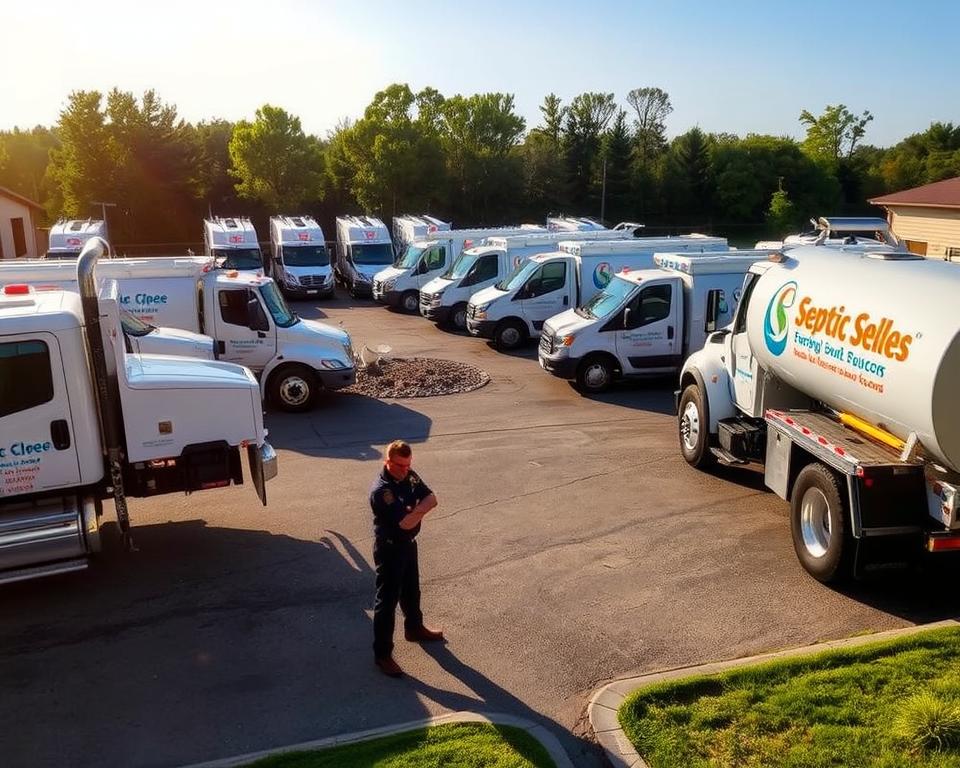Septic Ejector Pump: Essential Guide & Advice
Did you know that nearly 60 million households in the United States use septic systems for wastewater management? The septic ejector pump is a vital part of these systems. It moves wastewater from the septic tank to the effluent field or the city sewer main. This pump is very important for homes below the level of the sewage lines, preventing backups and guaranteeing proper drainage.
This guide will help you grasp how sewage ejector pumps function. It will also explain how to choose the appropriate pump for your home, the optimal way to install it, and how to maintain it in good working order. We’ll also talk about signs that your pump might require repair. With advice from experts and reliable sources like All In Site Services, we aim to make managing your home’s sewage system simpler.
Understanding a Sewage Ejector Pump?
A septic ejector pump is critical for homes not connected to city sewers. It’s made to elevate and transfer sewage and wastewater, even solid waste that regular pumps can’t process. Powered by a motor, it pushes waste from the septic tank to the drainage field or city sewers, keeping things sanitary.
How Septic Ejector Pumps Work
Septic ejector pumps are great at transporting both solids and liquids. When the septic tank reaches capacity, the pump kicks in. It uses pressure to push sewage upwards, even countering gravity. This is particularly beneficial for homes with basements or low plumbing.
It ensures wastewater moves fast, avoiding backups and keeping things clean.
Differences Between Ejector Pumps and Other Pumps
Sewage ejector pumps are different from other pumps, each with its own purpose in handling wastewater. Here’s how they compare:
| Type of Pump | Function | Solid Handling Capability |
|---|---|---|
| Sewage Ejector Pump | Transfers sewage from septic tanks to drainage systems | Handles up to 2 inches solids |
| Sewage Pump | Manages wastewater and sewage | Capable of handling 2 inches solids |
| Effluent Pump | Moves lighter wastewater and effluent | Some small solids |
| Drain Pump | Extracts water from basements and low areas | Limited debris handling |
This table shows how septic ejector pumps stand out from sewage and discharge pumps. They’re great at handling solid waste. Understanding these differences assists in picking the appropriate pump for your wastewater requirements.
Selecting the Correct Septic Ejector Pump for Your System
Choosing the appropriate septic tank pump out near me is crucial to a well-working system. It’s important to know what your system needs for the best performance. Looking at different factors can assist in a good choice.
Key Considerations When Choosing a Pump
When picking a septic system pump, consider these factors:
- TDH: This indicates how high the pump must elevate the waste. A higher TDH means you require a more powerful pump.
- Flow Rate: Figure out how much waste you need to pump in a certain time. This helps pick a pump that can handle the load.
- Pump Basin Capacity: Make sure your basin is adequately sized, at least 18×30 inches for homes. A larger basin helps the pump’s efficiency.
Popular Ejector Pump Types
Understanding about the different ejector pumps can help you make a informed choice:
| Pump Type | Overview | Best Use |
|---|---|---|
| Grinder Pump | Designed to grind solids into smaller particles for simplified transfer. | Suitable for locations with high solid content in sewage. |
| Elevator Pump | Handles larger volumes of water and solids effectively. | Perfect for larger residential systems or commercial uses. |
Brands like Zoeller and Liberty Pumps provide many models for different requirements. Doing your homework can assist in finding a pump that works well for you. This leads to a more efficient and reliable sewage system.
Septic Ejector Pump Installation Tips
Setting up a septic ejector pump is a detailed process. It demands careful planning and execution for optimal performance. Adhering to key steps and avoiding common mistakes can prevent future issues and improve your system’s performance.
Step-by-Step Installation Process
- Select the pump’s location, following local regulations and ensuring easy maintenance access.
- Prepare a stable, even base for the pump’s stability.
- Connect the pump to the septic tank and drainage system firmly.
- Install electrical components according to the pump’s specifications for effective sewage pump installation.
- Examine the system carefully before covering connections or closing access points.
Common Pitfalls to Avoid During Installation
- Improper pump sizing can lead to inefficiencies and excessive wear.
- Failing to seal connections correctly may cause leaks, affecting the system.
- Ignoring the pump’s electrical requirements can result in failures.
- Neglecting ventilation needs can worsen odors and pressure issues.
- Ignoring the manufacturer’s guide can result in overlooking important specifications.
| Typical Problems | Impact | Solution |
|---|---|---|
| Incorrect sizing | Reduced pump efficiency and increased energy costs | Consult specifications for necessary capacity |
| Poor sealing leaks | Contaminated water and odor issues | Apply high-quality sealing materials and techniques |
| Wiring issues | Frequent breakdowns of the pump | Check electrical requirements before installation |
| Poor ventilation | Odor buildup and system pressure issues | Provide adequate venting in lift station pump installation |
| Insufficient testing | Missing problems before closing the system | Conduct comprehensive tests pre-installation |
Top Maintenance Tips for Your Sewage Pump
Regular maintenance of your septic ejector pump is crucial to its extended performance and reliability. By following good care routines, you can enhance the pump’s efficiency. Here are some top tips to keep your pump in optimal condition:
- Check the pump twice a year for any debris that might obstruct it.
- Look at all electrical connections closely. Damaged wires can cause the pump to fail.
- Make sure the float switch is functioning properly. A broken switch can cause backups or overflows.
- Keep an eye on the wastewater levels in the basin. Catching problems early can reduce costs on repairs.
- Clean the sump basin regularly. This stops debris from hindering the pump’s operation.
- Schedule a professional inspection as needed. Specialists can ensure everything is in good condition.
Adhering to these steps will not only extend your sewage pump’s life but also ensure optimal performance. Keeping up with septic ejector pump maintenance is essential to avoid unexpected problems and maintain your sewage system operating efficiently.
Signs Your Septic Ejector Pump Needs Repair
Identifying when your sewage ejector pump needs repair is key to keeping your sewage system healthy. Strange noises from the pump can indicate mechanical issues. This could suggest your sewage pump has problems that need quick action.
If your pump operates intermittently more than usual, it might be overworking. This could suggest it can’t handle the system’s demands and needs inspection.
Foul odors near the pump are another significant red flag. These odors can indicate leaks or backups, showing the pump is not functioning properly. Seeing sewage backup in your plumbing is a clear sign repairs are needed. Fixing these issues fast can stop bigger problems and save you money later.
If your sewage lift pump doesn’t turn on when it should, it could be a serious problem. This could be due to a technical or electrical issue. Having it inspected or serviced quickly is crucial. Being proactive on these signs can prevent big problems and save you money and inconvenience.



